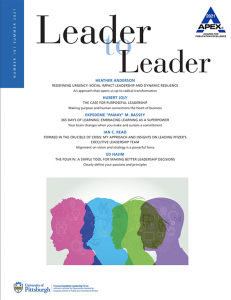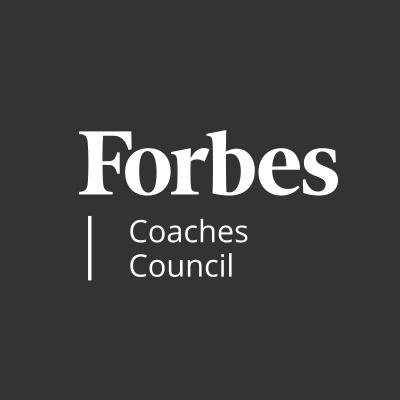 One of the best projects I ever worked on is described in the Summer 2021 issue of Leader to Leader in an article authored by Ian Read, Pfizer’s CEO from 2010 to 2018 entitled “Formed in the Crucible of Crisis: My Approach and Insights on Leading Pfizer’s Executive Leadership Team.” I collaborated on the article that speaks to Ian’s journey as a CEO, his lessons learned and special emphasis on leading through his executive leadership team. I worked with him in designing and running a key early offsite meeting that helped bring the ELT together around trust and candor. After reading the article, a colleague asked a key question: How does one get into the position to partner with a CEO in a meaningful way? My experience may offer at least one path.
One of the best projects I ever worked on is described in the Summer 2021 issue of Leader to Leader in an article authored by Ian Read, Pfizer’s CEO from 2010 to 2018 entitled “Formed in the Crucible of Crisis: My Approach and Insights on Leading Pfizer’s Executive Leadership Team.” I collaborated on the article that speaks to Ian’s journey as a CEO, his lessons learned and special emphasis on leading through his executive leadership team. I worked with him in designing and running a key early offsite meeting that helped bring the ELT together around trust and candor. After reading the article, a colleague asked a key question: How does one get into the position to partner with a CEO in a meaningful way? My experience may offer at least one path.
Let’s start with what builds trust. In Trust in the Balance, Robert Shaw’s classic book, he distilled three key aspects to building trust — results, integrity and concern — that I have seen hold true across time, different types of clients and even cultures (disclosure: Shaw is a friend and mentor). For memory’s sake, I turned Shaw’s three keys into the three Cs of trust: commitment, caring and consistency.
Delivering on commitments is the coin of the business realm, and is about trusted reliability so that someone can feel more comfortable risking their reputation with you. Genuinely caring about the other person drives deep listening and a feeling of being heard; it also shows a desire to help in sustainable ways and a willingness to do what is in service of the greater good rather than just for personal benefit. Acting consistently and ethically together enables predictability, contributing to psychological safety as described in The Fearless Organization by Amy C. Edmondson.
For the coach or consultant, I see four key points for building trust with any senior client — points that build off and extend Shaw’s framework and that came into play in my work with Ian.
1. Build trust by delivering on meaningful commitments.
To deliver creatively, you need to listen deeply to clients, drawing out what they want to do, why and what is most important to them about how it gets done. You guide the development of a creative approach with them, so the clients feel heard and know you have created something uniquely adapted to their needs. In working with Ian as the newly promoted CEO, that need was to promote trust through high candor dialogue, to demonstrate that all team members could speak their truth and ensure the team and company would benefit. I had an existing relationship with Ian built over years of delivering, thinking and acting with broader perspective, caring about his success and suggesting new approaches. If you don’t have the track record with the CEO, look to partner with the CEO’s key allies/reports and deliver for them.
2. Bring practical advice and counsel at an enterprise level along with guidance through implementation.
Consultants and coaches are often specialists, with deep knowledge in a few areas. For the CEO who must take an enterprise and even societal view, you build trust by demonstrating how you see the really big picture and how solutions can meet multiple needs and avoid unintended consequences. Narrow solutions loaded with jargon can give a CEO the impression that you’re more technologist than strategist. CEOs have to have, or develop, the right approach to the right problem, and enough execution follow-through to avoid a “flavor of the month” issue, especially when building the executive team. My approach included working after offsite meetings with Ian’s HR partner to ensure agreements got used. While I wasn’t able to schedule observations post-meeting with Ian, it has become a critical part of my work with leadership teams who often need structured support to fully break old habits and build the new ones they agreed to. Powerful, well-shared and in-the-moment observations can lead to deeper learning with the client and the full team, so they want the new discipline and habits that will make that specific team successful.
3. Work in a way that honors confidentiality.
I see the entire team as my client, not just the CEO. Confidentiality is created through open-enough dialogue that advances the effectiveness of the team. When collecting data through interviews of team members, it is critical to present the data thematically and anonymously, allowing team members to own the data and go deep enough, but not so deep that people are too uncomfortable and/or trust is diminished. I work to develop relationships with all team members, during interviews, while traveling to and from an offsite and in the follow-up work that supports implementation.
4. Help and learn from the client as to how things might go over the course of the work.
Customize your approach to building the team with the CEO, dialoguing on rollout challenges and opportunities. Influenced by Jon Katzenbach’s Teams at the Top, we worked to develop a true, disciplined approach that was robust enough for the ELT and their unique work. This can be a point of contention, as discipline is often resisted by CEOs and team members who believe they are above the need. I build the discipline as a consequence of developing the team’s unique value-added purpose and use that unique purpose to shape the right agenda the whole team can contribute to. We identify the right pre-, in- and post-meeting disciplines that enable great executive teamwork. Most importantly, the meeting is owned by the CEO in partnership with the consultant, rather than turned over to the consultant.
Delivering on the right commitments and doing so through practical advice and counsel at the enterprise and societal level make for a strong foundation for success with a CEO. Honoring confidentiality in service of building psychological safety and co-creating the unique purpose, agenda and discipline of the ELT can operationally enable great things for the CEO, for the team and for you as the consultant/coach.
Originally published at Forbes.com on Oct 20, 2021

